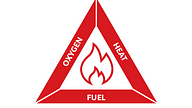Fire Suppression Basics: Fire Hazard Analysis
In case you missed any of the previous posts in the Vehicle Fire Suppression Basics series:
Part 5 of 8: Fire Hazard Analysis
An effective fire suppression system design is based on a thorough fire hazard analysis of the specific vehicle to be protected and its operating environment. In this blog post, we look at the key principles behind a fire hazard analysis and how they dictate system design parameters such as number and location of distribution nozzles, and quantity of extinguishing agent.
Back to the Start: The Fire Triangle

Fire Triangle
Fire hazards exist in any situation where a fuel source and an ignition source are combined in the presence of oxygen. When present, these three elements are able to sustain a chemical reaction that will keep a fire burning until at least one of the elements is either eliminated or isolated, breaking the chemical reaction.
Fuel and ignition sources are present in mobile equipment frequently used in industries such as mining, quarrying, aggregates, waste processing and recycling, bulk handling and wood processing.
- Common fuel sources in mobile equipment include flammable liquids such as diesel and hydraulic fluid, grease, rubber, plastics and environmental debris such as wood chips or coal dust. Vehicles with large amounts of combustible fuel (e.g. hydraulic fluid) are considered a special type of hazard.
- Common vehicle heat sources are engines, exhaust systems, pumps and turbochargers as well as bearings, gears, brakes and electrical equipment. A potential hazard exists where a fuel source comes into contact with a heat source.
Designing Fire Suppression Systems to Limit Fire Risk
Areas where a heat source and fuel source combine represent a fire hazard. Pre-engineered vehicle fire suppression systems use suppression agents to obstruct and inhibit the chemical reaction that sustains a fire when fuel, heat and oxygen are combined. As oxygen will always be present and cannot be easily excluded, the systems focus on isolating and controlling the fuel and heat sources.
A fire suppression system designed to provide full hazard protection looks at the heat and fuel sources in the vehicle. This analysis helps to determine where the fire hazards are and necessary steps to protect the vehicle and operator can be taken.
Even when all the fire hazards in the vehicle are considered, fires may occur as a result of unforeseeable (fuel spills, welding heat, etc.) and these fires may happen in areas that are not protected by the fire suppression system. Therefore, a handheld portable fire extinguisher adds a degree of flexibility and extends the reach of the system.
Local Application (Hazard Protection) vs Total Flooding (Volume Protection)
Fire suppression systems can be designed using a total flooding or local application method. In the fire protection industry, these methods are used to protect different spaces and pieces of equipment.
- Total flooding is commonly described as volume protection and it should only be applied when protecting hazards that are located inside an enclosure, like a room or an electrical cabinet. Openings such as doors, windows and gratings shall not be more than 15% of the enclosure's total surface area. Total flooding is accomplished by introducing a sufficient quantity of agent throughout the volume of the enclosure to suffocate the fire. With gas fire suppression systems, this is the amount of suppression agent required to reduce the oxygen concentration to below the required levels for combustion.
- When designing a local application system, each individual fire hazard area must be surveyed, and the correct number and location of nozzles must be chosen to give the proper coverage. This type of system design is used for mobile equipment protection, where fire hazards aren't located in an enclosed space. Each nozzle is critically positioned to protect each fire hazard in the vehicle. There must be enough extinguishing agent to supply each nozzle with the required flow rate to suppress a fire in the hazard area.
It is important to consider that the engine compartment in mobile equipment doesn't constitute an enclosure and therefore a total flooding design isn't suitable. In addition, fire hazards such as transmission, hydraulic hoses and control valves, slew motors and parking brakes are located outside the engine compartment. Based on Ardent's experience in vehicle fire protection, around 25% of fires in heavy mobile equipment originate outside the engine compartment.
A local application design based on a thorough hazard analysis is recommended, as it provides the highest level of protection against fire in mobile equipment.
Next blog post in the Vehicle Fire Suppression Basics series: Nozzle Coverage and Location.
Related News

Fire Suppression Basics: Suppression Agent Tanks
No fire suppression system is complete without the correct suppression agent tanks. In this blog post, we look at the two main types of tanks.

Fire Suppression Basics: Control Systems
Extinguishing agents and detectors are key components of any system, but it is the control module that dictates the response to fire.

Fire Suppression Basics: Detection Systems
Even the most effective extinguishing agents depend upon a reliable detection system. Here we look at the most common types and their pros and cons.
